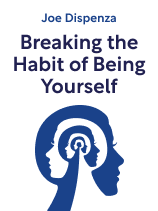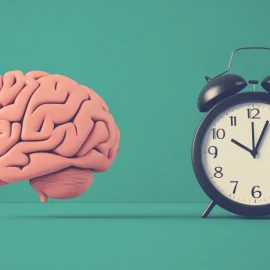

This article is an excerpt from the Shortform book guide to "Breaking the Habit of Being Yourself" by Joe Dispenza. Shortform has the world's best summaries and analyses of books you should be reading.
Like this article? Sign up for a free trial here.
What are alpha brain waves? How can you put your brain into an alpha frequency on demand?
Alpha brain waves are low-range brainwaves associated with a state of calm and relaxation. In his book Breaking the Habit of Being Yourself, Joe Dispenza recommends an alpha brain waves meditation practice to induce a state of alert calm.
Keep reading to learn how to put your brain into the alpha frequency.
What Are Brain Waves?
Your brain’s electrical activity can occur at different wave frequencies, and these frequencies reflect your state of mind and how attuned you are to the outside world. High wave frequencies mean you’re alert and thinking, and low wave frequencies mean you’re calm and not as cognitively active. Let’s look at each wave frequency.
- Beta: As adults, we spend most of our time in the high-frequency beta state, consciously thinking and processing the stimuli around us using our neocortex.
- Alpha: When we slow our thinking and start to tune out sensory stimuli, we slip into lower-frequency alpha waves where we’re in an imaginative state that helps us learn and retain new information.
- Theta: In theta, our brainwave frequency slows until we’re practically half-asleep, with the conscious mind being awake while the body is in a close-to-sleep state. The conscious and subconscious minds are no longer separated.
- Delta: Delta is the lowest wave frequency and occurs when we’re deeply asleep.
| The Functions of Different Brainwaves These four brainwave frequencies provide us with different benefits, which Dispenza doesn’t discuss. Let’s look at those benefits: Beta brainwaves help us with energy and motivation and keep us clear-headed and able to perform more difficult cognitive tasks like analysis. However, excessive beta activity can impair our focus and make us tense and anxious. Alpha brainwaves are important for emotional regulation, as they can reduce anxiety and depression. They also promote creativity and focus. However, if alpha waves occur during a specific stage of sleep it can cause sleep disruptions and disorders. Theta brainwaves provide deep relaxation and calm and can help with the formation of memories and other subconscious activities. Excessive theta wave activity seems to be associated with ADHD and certain mental illnesses. Delta brainwaves during sleep are what provide deep rejuvenation and restoration of the brain and improve your immune system and sleep patterns. Too much delta activity when awake can cause poor concentration and is associated with brain injuries and conditions like ADHD. |
How to Lower Your Frequency
Dispenza describes two alpha brain waves meditation methods for lowering the frequency of your brainwaves. These techniques will shift your state of being from one of thinking to one of feeling and put you in touch with your subconscious mind. You’ll perform this and all subsequent steps while seated upright with your eyes closed.
To enter these lower frequency states, focus your attention on the space you’re occupying—both the physical space your body takes up and the space of the room you’re in. You may do this in a top-down technique, where you begin by focusing first on your head and then moving your attention down your body, part by part, until you reach your feet. Then, sense the space your body takes up as a whole, and finally, the space of the room you’re in.
Alternatively, you can use a bottom-up approach, where you begin by sensing the space of the whole room and then sensing the space from your feet up to the top of your head. Dispenza suggests imagining that water is filling the room for this approach.
| Other Methods of Changing Your Brainwaves In addition to Dispenza’s induction method, there are a number of ways you can manipulate your brainwave frequencies. Brainwave entrainment is a phenomenon by which brainwaves become synchronized in response to stimuli like sounds. This method has been used by different cultures for centuries through practices like drumming and chanting. Types of brainwave entrainment include binaural and monaural beats, both of which involve playing two notes of different frequencies—or pitch—which prompts the brain to create a tone in between the two frequencies. The brain will then adjust its waves to synchronize with this perceived third frequency. Another method of controlling your brainwaves is neurofeedback, which allows you to view your own brainwave activity on a screen so you can learn to consciously move in and out of different brainwave frequencies. This method is often used to treat ADHD and mental illness, and you can also use it to maximize your mental performance. |

———End of Preview———
Like what you just read? Read the rest of the world's best book summary and analysis of Joe Dispenza's "Breaking the Habit of Being Yourself" at Shortform.
Here's what you'll find in our full Breaking the Habit of Being Yourself summary:
- How your habits are keeping you from growing
- How to unlearn your harmful habits to create a new you
- A four-step meditative practice to help you learn new habits







This article provides a clear explanation of alpha brain waves and how they relate to meditation. I appreciate the detailed breakdown of the different brainwave states. It’s fascinating to see how meditation can actively shift our brainwave patterns.